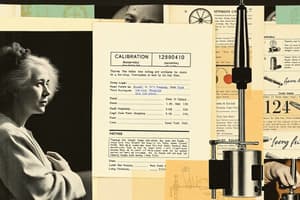Podcast
Questions and Answers
What does preventive maintenance involve?
What does preventive maintenance involve?
- Performing maintenance activities only when a breakdown occurs
- Addressing failures after they occur
- Monitoring equipment performance
- Regular maintenance activities to prevent breakdowns (correct)
Predictive maintenance involves using data and analytics to predict when maintenance activities are required.
Predictive maintenance involves using data and analytics to predict when maintenance activities are required.
True (A)
What does TPM stand for?
What does TPM stand for?
Total Productive Maintenance
Seals are components that prevent the leakage of _____________ between moving parts.
Seals are components that prevent the leakage of _____________ between moving parts.
Match the following concepts with their definitions:
Match the following concepts with their definitions:
What is availability in maintenance technology?
What is availability in maintenance technology?
What functions are typically included in the organization of a maintenance department?
What functions are typically included in the organization of a maintenance department?
Lubrication is a critical maintenance activity that helps reduce friction and wear between moving parts. Bearings are particularly susceptible to damage due to lack of ________.
Lubrication is a critical maintenance activity that helps reduce friction and wear between moving parts. Bearings are particularly susceptible to damage due to lack of ________.
Match the following maintenance functions with their descriptions:
Match the following maintenance functions with their descriptions:
Study Notes
Maintenance Practice
- Theoretical aspects of maintenance practice include:
- Preventive Maintenance: performing maintenance activities on a regular basis to prevent breakdowns and ensure efficient operation
- Predictive Maintenance: using data and analytics to predict when maintenance activities are required
- Total Productive Maintenance (TPM): involving all employees in the maintenance process to improve equipment effectiveness
- Reliability Centered Maintenance (RCM): determining the optimal maintenance strategy for each piece of equipment based on its criticality and the consequences of failure
- Practical aspects of maintenance practice include:
- Maintenance Planning and Scheduling: developing a maintenance plan, scheduling maintenance tasks, and ensuring that maintenance activities are performed on time
- Maintenance Execution: performing maintenance activities according to the maintenance plan
- Maintenance Record Keeping: documenting maintenance activities for each piece of equipment
- Root Cause Analysis: identifying the underlying causes of equipment failures
- Continuous Improvement: continually improving maintenance practices to increase efficiency and reduce downtime
- Condition Monitoring: monitoring equipment performance to identify potential issues before they become major problems
- Training and Development: providing employees with the knowledge and skills needed to perform maintenance activities safely and effectively
- Asset Management: managing the entire life cycle of equipment, from acquisition to disposal
Damages of Typical Components of Machinery
- Bearings: common causes of damage include lack of lubrication, contamination, misalignment, and overloading
- Gears: common causes of damage include wear, pitting, and cracking due to overloading or improper meshing
- Shafts: common causes of damage include bending, fatigue, and wear
- Seals: common causes of damage include wear, improper installation, and contamination
- Belts: common causes of damage include wear, stretching, and improper tensioning
- Electrical Components: common causes of damage include overloading, overheating, and electrical surges
- Hydraulic Components: common causes of damage include wear, corrosion, contamination, and overloading
Reliability, Maintainability, and Availability
- Reliability: the ability of a system or component to perform its intended function without failure under given conditions for a specified period
- Maintainability: the ability of a system or component to be maintained in a state of repair or functioning under given conditions for a specified period
- Availability: the proportion of time that a system or component is operating and able to perform its intended function when required
- These concepts are interrelated and are used to evaluate the overall effectiveness of maintenance activities
Organization of a Maintenance Department
- Maintenance Planning: responsible for developing and implementing maintenance plans and schedules
- Maintenance Execution: responsible for performing maintenance activities according to the maintenance plan
- Maintenance Engineering: responsible for providing technical support to the maintenance department
- Maintenance Administration: responsible for managing the administrative aspects of the maintenance department
Maintenance Planning and Decision Making Processes
- Identifying maintenance needs: assessing equipment performance data, identifying potential issues, and determining the scope of maintenance activities required
- Prioritizing maintenance needs: evaluating the consequences of failure, determining the likelihood of failure, and prioritizing maintenance activities accordingly
- Developing maintenance plans: developing a maintenance schedule, identifying maintenance tasks, and determining the frequency of maintenance activities
- Implementing maintenance plans: performing maintenance activities according to the maintenance schedule
- Monitoring and evaluating maintenance performance: tracking maintenance history, identifying trends, and evaluating the effectiveness of maintenance strategies
- Continuous improvement: analyzing maintenance performance data, identifying areas for improvement, and implementing improvement strategies to optimize maintenance operations and improve equipment reliability and performance
Studying That Suits You
Use AI to generate personalized quizzes and flashcards to suit your learning preferences.
Description
This quiz covers the concept of availability in maintenance technology, its impact on production output, and how it affects overall equipment effectiveness. It also explores how monitoring availability helps maintenance teams identify bottlenecks and prioritize activities.




